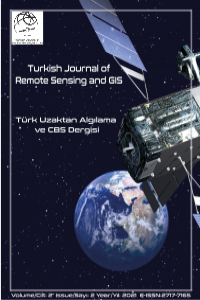Research Article
Year 2021,
Volume: 2 Issue: 2, 59 - 66, 29.09.2021
Abstract
Hızlı nüfus artışının kentlerde oluşturduğu kaos ortamının yönetilebilir ve kontrol edilebilir olması gerekir. Kentlerde plan kararlarının uygulanmasında önemli bir yere sahip olan kentsel büyüme ve simülasyon modelleri bu planların uygulanabilirliği açısından önem kazanmaktadır. Kentlerdeki büyümenin incelenmesinde kullanılan hücresel otomat (HO) temelli modeller ve bu modeller arasında da SLEUTH yazılımı en çok tercih edilenlerdendir. SLEUTH ile simülasyon modeli üç aşamada oluşturulmaktadır; test, kalibrasyon ve kestirim. Kalibrasyon aşamasında model için en uygun büyüme katsayısı değerlerinin Optimum Sleuth Metric (OSM) yöntemi ile hesaplanması amaçlanır. En uygun katsayı değerleri, hesaplanan 13 adet ölçüte göre Brute Force Calibration (BFC) yöntemi ile belirlenmektedir. Literatürde sıklıkla OSM ve Lee-Sallee yöntemleri kullanılmasına rağmen 13 ölçütten hangisinin veya hangilerinin kalibrasyon aşamasında katsayı belirlemede kullanılacağı konusunda henüz fikir birliği yoktur. Bu kapsamda çalışmada OSM yöntemi kullanılarak İstanbul için bir kentsel büyüme simülasyon modeli oluşturulmuştur. Elde edilen sonuçlar 2040 yılında tarım alanlarının %83,50’sinin orman alanlarının ise %58,30’unun kentleşme potansiyeli taşıdığını göstermektedir.
References
- Ayazlı, İ. E (2011). Ulaşım ağlarının etkisiyle kentsel yayılmanın simülasyon modeli: 3. boğaz köprüsü örneği (Doktora Tezi), Yıldız Teknik Üniversitesi, İstanbul, Türkiye.
- Ayazlı, İ. E., Kılıç, F., & Demir, H. (2013). The determining of the Bosphorus bridges effects on urban growth using simulation. Sigma Journal of Engineering and Natural Sciences, 31(2), 235-245.
- Ayazlı, İ. E., (2022). Hızlı büyüyen yerleşim yerlerinde kentsel büyümenin yüksek doğruluklu simülasyon modelleri ile izlenmesi: Model kalibrasyonu için T-AFA yöntemi önerisi. Geomatik, 7(1), 1-9. doi: 10.29128/geomatik.764579.
- Dietzel, C., & Clarke, K. (2006). The effect of disaggregating land use categories in cellular automata during model calibration and forecasting. Computers, Environment and Urban Systems, 30(1), 78-101.
- Dietzel, C., & Clarke, K. C. (2007). Toward optimal calibration of the SLEUTH land use change model. Transactions in GIS, 11(1), 29-45.
- Gigalopolis. (2019, Aralık 27). Project Gigalopolis. Retrived From http://www.ncgia.ucsb.edu/projects/gig/
- Gigalopolis. (2020, Ocak 8). Project Gigalopolis. Retrived From http://www.ncgia.ucsb.edu/projects/gig/
- Hammam, Y., Moore, A., Whigham, P., & Freeman, C. (2004, November). Irregular vector-agent based simulation for land-use modelling. In 16th Annual Colloquium of the Spatial Information Research Centre (SIRC 2004: A Spatio-temporal Workshop), 2004. Proceedings. (pp. 103-116). Dunedin, New Zealand.
- Kana, D. (2006). İstanbul’da kentleşme ve değişim (Yüksek Lisans Tezi). Marmara Üniversitesi, İstanbul, Türkiye.
- White, R., Straatman, B., & Engelen, G. (2004). Planning scenario visualization and assessment: a cellular automata based integrated spatial decision support system. In G. Goodchild, M. F. & D: Janelle (Eds.), Spatially integrated social science (pp. 420–442). New York, NY: Oxford University Press.
- Yakup, A. E. (2018). Mülkiyet yapısının kentsel büyümeye etkisinin simülasyon ile araştırılması (Yüksek Lisans Tezi). Cumhuriyet Üniversitesi, Sivas, Türkiye.
Year 2021,
Volume: 2 Issue: 2, 59 - 66, 29.09.2021
Abstract
The chaos environment created by rapid population growth in cities must be manageable and controllable. Urban growth and simulation models which are important for applying planned changes also have a crucial role in terms of applicability of these plans. The SLEUTH programme is the mostly preferred one among the cellular automata based models that are used for analyzing urban growth. Simulations with SLEUTH are completed in 3 stages: test, calibration and prediction. During calibration period, it is aimed to calculate the optimum growth coefficient values through the Optimum Sleuth Metric (OSM). The optimum coefficient values are calculated conforming to 13 metrics by using Brute Force Calibration technique. Although the OSM and Lee-Sallee techniques are frequently encountered in literature, there is no consensus upon which one or ones of the 13 metrics are to be used for determining coefficient values during calibration. Within this scope, in this study, an urban growth simulation model for Istanbul was created by using the OSM technique. According to the results, in the year 2040, %83,50 of agricultural lands and %58,30 of forest lands will have the potential for urbanization.
References
- Ayazlı, İ. E (2011). Ulaşım ağlarının etkisiyle kentsel yayılmanın simülasyon modeli: 3. boğaz köprüsü örneği (Doktora Tezi), Yıldız Teknik Üniversitesi, İstanbul, Türkiye.
- Ayazlı, İ. E., Kılıç, F., & Demir, H. (2013). The determining of the Bosphorus bridges effects on urban growth using simulation. Sigma Journal of Engineering and Natural Sciences, 31(2), 235-245.
- Ayazlı, İ. E., (2022). Hızlı büyüyen yerleşim yerlerinde kentsel büyümenin yüksek doğruluklu simülasyon modelleri ile izlenmesi: Model kalibrasyonu için T-AFA yöntemi önerisi. Geomatik, 7(1), 1-9. doi: 10.29128/geomatik.764579.
- Dietzel, C., & Clarke, K. (2006). The effect of disaggregating land use categories in cellular automata during model calibration and forecasting. Computers, Environment and Urban Systems, 30(1), 78-101.
- Dietzel, C., & Clarke, K. C. (2007). Toward optimal calibration of the SLEUTH land use change model. Transactions in GIS, 11(1), 29-45.
- Gigalopolis. (2019, Aralık 27). Project Gigalopolis. Retrived From http://www.ncgia.ucsb.edu/projects/gig/
- Gigalopolis. (2020, Ocak 8). Project Gigalopolis. Retrived From http://www.ncgia.ucsb.edu/projects/gig/
- Hammam, Y., Moore, A., Whigham, P., & Freeman, C. (2004, November). Irregular vector-agent based simulation for land-use modelling. In 16th Annual Colloquium of the Spatial Information Research Centre (SIRC 2004: A Spatio-temporal Workshop), 2004. Proceedings. (pp. 103-116). Dunedin, New Zealand.
- Kana, D. (2006). İstanbul’da kentleşme ve değişim (Yüksek Lisans Tezi). Marmara Üniversitesi, İstanbul, Türkiye.
- White, R., Straatman, B., & Engelen, G. (2004). Planning scenario visualization and assessment: a cellular automata based integrated spatial decision support system. In G. Goodchild, M. F. & D: Janelle (Eds.), Spatially integrated social science (pp. 420–442). New York, NY: Oxford University Press.
- Yakup, A. E. (2018). Mülkiyet yapısının kentsel büyümeye etkisinin simülasyon ile araştırılması (Yüksek Lisans Tezi). Cumhuriyet Üniversitesi, Sivas, Türkiye.
There are 11 citations in total.
Details
| Primary Language | Turkish |
|---|---|
| Subjects | Photogrammetry and Remote Sensing |
| Journal Section | Research Articles |
| Authors | |
| Publication Date | September 29, 2021 |
| Submission Date | May 26, 2021 |
| Acceptance Date | September 9, 2021 |
| Published in Issue | Year 2021 Volume: 2 Issue: 2 |

This journal is licensed under a Creative Commons Attribution-NonCommercial-NoDerivatives 4.0 International License.


